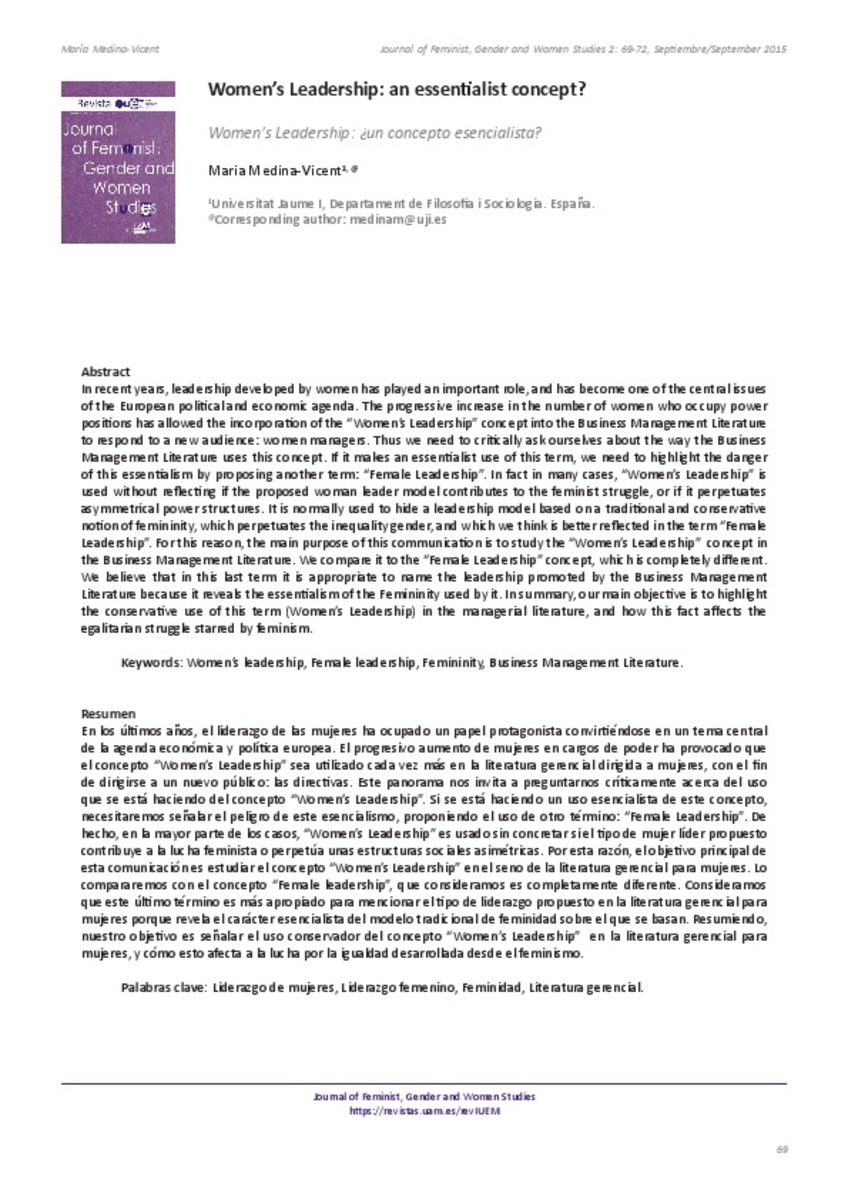Mostrar el registro sencillo del ítem
Women’s Leadership: an essentialist concept?
| dc.contributor.author | Medina-Vicent, Maria | |
| dc.date.accessioned | 2015-12-03T10:23:11Z | |
| dc.date.available | 2015-12-03T10:23:11Z | |
| dc.date.issued | 2015-09 | |
| dc.identifier.issn | 2444-1198 | |
| dc.identifier.uri | http://hdl.handle.net/10234/142485 | |
| dc.description.abstract | In recent years, leadership developed by women has played an important role, and has become one of the central issues of the European political and economic agenda. The progressive increase in the number of women who occupy power positions has allowed the incorporation of the “Women’s Leadership” concept into the Business Management Literature to respond to a new audience: women managers. Thus we need to critically ask ourselves about the way the Business Management Literature uses this concept. If it makes an essentialist use of this term, we need to highlight the danger of this essentialism by proposing another term: “Female Leadership”. In fact in many cases, “Women’s Leadership” is used without reflecting if the proposed woman leader model contributes to the feminist struggle, or if it perpetuates asymmetrical power structures. It is normally used to hide a leadership model based on a traditional and conservative notion of femininity, which perpetuates the inequality gender, and which we think is better reflected in the term “Female Leadership”. For this reason, the main purpose of this communication is to study the “Women’s Leadership” concept in the Business Management Literature. We compare it to the “Female Leadership” concept, which is completely different. We believe that in this last term it is appropriate to name the leadership promoted by the Business Management Literature because it reveals the essentialism of the Femininity used by it. In summary, our main objective is to highlight the conservative use of this term (Women’s Leadership) in the managerial literature, and how this fact affects the egalitarian struggle starred by feminism. | ca_CA |
| dc.description.abstract | En los últimos años, el liderazgo de las mujeres ha ocupado un papel protagonista convirtiéndose en un tema central de la agenda económica y política europea. El progresivo aumento de mujeres en cargos de poder ha provocado que el concepto “Women’s Leadership” sea utilizado cada vez más en la literatura gerencial dirigida a mujeres, con el fin de dirigirse a un nuevo público: las directivas. Este panorama nos invita a preguntarnos críticamente acerca del uso que se está haciendo del concepto “Women’s Leadership”. Si se está haciendo un uso esencialista de este concepto, necesitaremos señalar el peligro de este esencialismo, proponiendo el uso de otro término: “Female Leadership”. De hecho, en la mayor parte de los casos, “Women’s Leadership” es usado sin concretar si el tipo de mujer líder propuesto contribuye a la lucha feminista o perpetúa unas estructuras sociales asimétricas. Por esta razón, el objetivo principal de esta comunicación es estudiar el concepto “Women’s Leadership” en el seno de la literatura gerencial para mujeres. Lo compararemos con el concepto “Female leadership”, que consideramos es completamente diferente. Consideramos que este último término es más apropiado para mencionar el tipo de liderazgo propuesto en la literatura gerencial para mujeres porque revela el carácter esencialista del modelo tradicional de feminidad sobre el que se basan. Resumiendo, nuestro objetivo es señalar el uso conservador del concepto “Women’s Leadership” en la literatura gerencial para mujeres, y cómo esto afecta a la lucha por la igualdad desarrollada desde el feminismo. | ca_CA |
| dc.description.sponsorShip | Proyecto de Investigación Científica y Desarrollo Tecnológico – FI2013-47136-C2-2-P, financiado por el Ministerio de Economía y Competitividad del Gobierno de España | ca_CA |
| dc.format.extent | 4 p. | ca_CA |
| dc.format.mimetype | application/pdf | ca_CA |
| dc.language.iso | eng | ca_CA |
| dc.publisher | Instituto Universitario de Estudios de la Mujer (IUEM) | ca_CA |
| dc.publisher | Universidad Autónoma de Madrid (UAM) | ca_CA |
| dc.relation.isPartOf | Journal of Feminist, Gender and Women Studies (2015) n. 2, p. 69-72 | ca_CA |
| dc.rights.uri | http://rightsstatements.org/vocab/CNE/1.0/ | * |
| dc.subject | women’s leadership | ca_CA |
| dc.subject | female leadership | ca_CA |
| dc.subject | femininity | ca_CA |
| dc.subject | Business Management Literature | ca_CA |
| dc.subject | liderazgo de mujeres | ca_CA |
| dc.subject | liderazgo femenino | ca_CA |
| dc.subject | feminidad | ca_CA |
| dc.subject | Literatura gerencial | ca_CA |
| dc.title | Women’s Leadership: an essentialist concept? | ca_CA |
| dc.title.alternative | Women’s Leadership: ¿un concepto esencialista? | ca_CA |
| dc.type | info:eu-repo/semantics/article | ca_CA |
| dc.rights.accessRights | info:eu-repo/semantics/openAccess | ca_CA |
| dc.relation.publisherVersion | https://revistas.uam.es/revIUEM/article/view/2229/2347 | ca_CA |
| dc.edition | Versió editorial | ca_CA |
Ficheros en el ítem
Este ítem aparece en la(s) siguiente(s) colección(ones)
-
FIS_Articles [511]
Articles de publicacions periòdiques







